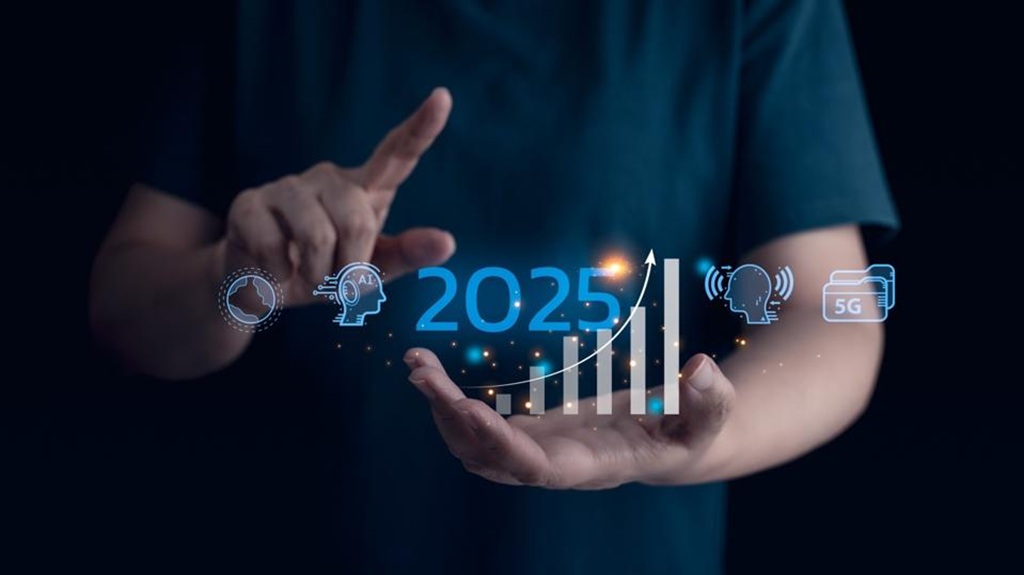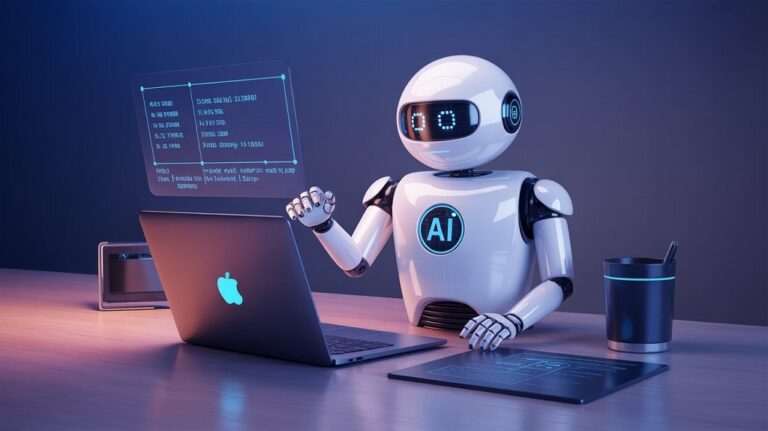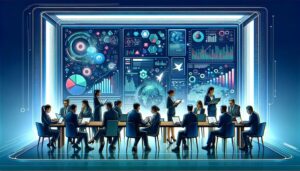The relentless march of Artificial Intelligence (AI) continues to reshape the business landscape. What was once a futuristic concept is now a tangible force driving innovation, efficiency, and competitive advantage. As we navigate 2025, understanding and leveraging the latest AI trends is no longer optional but critical for businesses aiming to thrive in an increasingly digital world. From hyper-personalization to AI-driven autonomous systems, these advancements promise to revolutionize operations, enhance customer experiences, and unlock unprecedented growth opportunities. This article delves into the top 10 AI trends poised to transform your business, offering insights into their potential and practical applications.
The AI Revolution: Key Trends to Watch
The AI ecosystem is dynamic, with new breakthroughs emerging at a rapid pace. For businesses, staying ahead of the curve means identifying and strategically implementing those trends that align with their goals and offer the most significant impact. Below are the pivotal AI developments demanding your attention in 2025.
-
The Ubiquitous Rise of Generative AI
Generative AI, which encompasses AI models capable of creating new content (text, images, audio, video, and even code), has moved beyond a novelty to become a fundamental business tool. In 2025, its integration across various platforms and applications will deepen significantly. We’re seeing more sophisticated Large Language Models (LLMs) and diffusion models that can produce highly realistic and contextually relevant outputs. This trend is fueled by advancements in model training, increased accessibility through APIs and no-code platforms, and a growing understanding of how to harness its power effectively. Businesses are increasingly exploring custom generative AI solutions tailored to their specific data and brand voice.
The implications for businesses are vast. In marketing, generative AI is revolutionizing content creation, enabling the rapid production of ad copy, social media posts, and even video scripts. Product development teams are using it to generate design prototypes and simulate product performance. Customer service departments are deploying advanced AI chatbots capable of handling complex queries with a human-like touch. Furthermore, generative AI is streamlining software development through AI-assisted coding and automated documentation. The focus in 2025 is shifting from mere experimentation to strategic deployment, with companies investing in training their workforce to collaborate effectively with these powerful tools and establishing ethical guidelines for their use. The ability to rapidly generate personalized content and solutions at scale is a game-changer for businesses of all sizes.
-
Hyper-Personalization at Scale
While personalization has been a marketing buzzword for years, AI is taking it to an entirely new level: hyper-personalization. This involves leveraging deep learning algorithms and vast datasets to understand individual customer preferences, behaviors, and needs with unprecedented accuracy. In 2025, businesses will move beyond segment-based targeting to deliver truly one-to-one experiences across all touchpoints, from website interactions and email campaigns to product recommendations and in-app experiences. This trend is powered by the convergence of big data analytics, machine learning, and real-time data processing capabilities.
Imagine a retail website that dynamically reconfigures its layout and product suggestions in real-time based on a user’s Browse history, past purchases, and even inferred intent from mouse movements. Consider a streaming service that curates not just a personalized watchlist but also adjusts its promotional content and communication style to match each user’s profile. This is the power of AI-driven hyper-personalization. Businesses investing in this trend are seeing significant improvements in customer engagement, conversion rates, and loyalty. The key is not just collecting data but intelligently interpreting and acting upon it to create experiences that make customers feel uniquely understood and valued. This requires robust data infrastructure, sophisticated AI models, and a commitment to privacy and ethical data handling.
-
AI-Powered Autonomous Systems and Decision Intelligence
The drive towards automation is intensifying, with AI-powered autonomous systems becoming more prevalent in 2025. These systems can perform complex tasks and make decisions with minimal human intervention. This extends beyond robotic process automation (RPA) to encompass more sophisticated applications like autonomous vehicles, smart factories, and self-optimizing supply chains. Coupled with this is the rise of Decision Intelligence, a practical discipline that augments data science with theory from social science, decision theory, and managerial science. AI algorithms are becoming crucial in analyzing vast amounts of data to provide actionable insights and even automate decision-making processes in areas like financial trading, inventory management, and dynamic pricing.
Businesses are leveraging AI-powered autonomous systems to enhance operational efficiency, reduce errors, and free up human workers for more strategic and creative endeavors. In manufacturing, AI-driven robots are performing intricate assembly tasks and conducting quality control with remarkable precision. Logistics companies are employing autonomous drones and vehicles for delivery and warehouse management. Decision Intelligence, powered by AI, is enabling leaders to make faster, more informed choices by simulating potential outcomes of various strategies and identifying optimal paths. This trend is not about replacing human oversight entirely but rather augmenting human capabilities. The challenge lies in building trust in these autonomous systems and ensuring their decisions align with ethical considerations and business objectives. Robust testing, transparent algorithms (Explainable AI), and human-in-the-loop safeguards are crucial for successful implementation.
-
The Maturation of Multimodal AI
AI is no longer confined to processing a single type of data. Multimodal AI, which can understand and process information from multiple sources and formats simultaneously (e.g., text, images, audio, video, and sensor data), is rapidly maturing. In 2025, we are seeing a surge in applications that can interpret and generate content across these different modalities, leading to more intuitive and human-like interactions with technology. Think of AI systems that can watch a video, understand its content, and generate a textual summary, or listen to a spoken query and respond with a relevant image or graph.
The implications of multimodal AI are transformative for various industries. In healthcare, it can help analyze medical images alongside patient history (text) and EKG readings (sensor data) for more accurate diagnoses. In education, it can create more engaging and interactive learning materials that combine text, visuals, and audio. For content creators, multimodal AI tools can streamline workflows by generating images from text descriptions or creating video summaries from articles. Customer service can be enhanced by AI that understands a customer’s spoken issue while simultaneously analyzing their facial expressions (if on video call) to gauge sentiment. As these systems become more adept at understanding the world in a holistic way, similar to humans, they will unlock new levels of automation, insight, and user experience.
-
Responsible AI: Ethics, Governance, and Trust
As AI systems become more powerful and integrated into critical business functions, the focus on Responsible AI is paramount. This encompasses fairness, transparency (Explainable AI or XAI), accountability, privacy, security, and safety. In 2025, businesses are under increasing pressure from regulators, consumers, and internal stakeholders to develop and deploy AI ethically and responsibly. This involves establishing robust governance frameworks, conducting bias audits, ensuring data privacy, and building systems that are interpretable and whose decisions can be understood and challenged.
The “black box” nature of some AI models is no longer acceptable, especially in sensitive areas like lending, hiring, and criminal justice. Businesses are investing in XAI techniques that provide insights into how AI models arrive at their conclusions. This not only helps in debugging and improving models but also builds trust with users and regulators. Proactive measures to identify and mitigate biases in training data and algorithms are crucial to prevent discriminatory outcomes. Furthermore, with growing concerns about data privacy, companies are adopting privacy-preserving AI techniques like federated learning and differential privacy. In 2025, responsible AI is not just a compliance requirement but a key differentiator that can enhance brand reputation and foster customer loyalty.
-
AI in Cybersecurity: Proactive Defense
![]()
The cybersecurity landscape is a constant arms race, and AI has become a critical weapon for both attackers and defenders. In 2025, AI’s role in cybersecurity is shifting from reactive detection to proactive threat hunting and automated response. Machine learning algorithms are being trained to identify subtle patterns and anomalies in network traffic, user behavior, and system logs that might indicate a sophisticated cyberattack, including zero-day exploits and advanced persistent threats (APTs).
AI-powered cybersecurity solutions can analyze vast amounts of threat intelligence data in real-time, enabling organizations to anticipate and neutralize threats before they cause significant damage. These systems can automate tasks like vulnerability assessment, intrusion detection, and even incident response, reducing the burden on human security analysts and enabling faster reaction times. For instance, AI can automatically isolate infected endpoints or block malicious IP addresses. As cybercriminals also leverage AI to create more sophisticated attacks (e.g., deepfake phishing, AI-generated malware), businesses must invest in equally advanced AI-driven defense mechanisms to stay protected. The focus is on building resilient security postures that can adapt to the evolving threat landscape.
Related: Creating Immersive Brand Experiences: A Deep Dive into Captivating Your Audience
-
AI-Augmented Workforce and Collaborative Intelligence
The narrative around AI is shifting from job replacement to job augmentation. In 2025, the trend of an AI-augmented workforce, where humans and AI collaborate to achieve better outcomes, is gaining significant traction. AI tools are increasingly designed to assist employees with their daily tasks, automate repetitive processes, provide data-driven insights, and enhance decision-making. This synergy, often referred to as collaborative intelligence, aims to boost productivity and allow human workers to focus on higher-value activities that require creativity, critical thinking, and emotional intelligence.
From AI assistants helping executives manage their schedules and prioritize tasks to sophisticated software aiding engineers in complex design and analysis, AI is becoming an indispensable partner in the workplace. Sales teams are using AI to identify promising leads and personalize outreach. Marketing professionals are leveraging AI for content optimization and campaign management. In customer service, AI handles routine inquiries, freeing up human agents to deal with more complex and empathetic customer interactions. The key to successfully implementing an AI-augmented workforce lies in providing employees with the necessary training and skills to effectively use these new tools and redesigning workflows to maximize the benefits of human-AI collaboration.
-
Edge AI: Processing Power Closer to the Source
While cloud-based AI has been dominant, Edge AI – processing AI algorithms directly on local devices or servers near the data source – is rapidly gaining prominence in 2025. This approach offers significant advantages in terms of reduced latency, lower bandwidth requirements, improved privacy, and operational reliability, especially in scenarios where real-time processing is critical or connectivity is limited. We are seeing more powerful and energy-efficient AI chips designed specifically for edge devices.
Edge AI is crucial for applications like autonomous vehicles, industrial robotics, healthcare monitoring devices, and smart retail solutions. For example, in a factory, an AI-powered camera on the assembly line can detect defects in real-time without sending data to the cloud, enabling immediate corrective action. In healthcare, wearable devices can analyze patient vitals locally and alert caregivers to emergencies. For retailers, edge AI can power in-store analytics and personalized experiences without compromising customer data privacy. As the Internet of Things (IoT) continues to expand, the demand for edge AI will only grow, enabling a new class of intelligent and responsive applications that operate closer to where the action happens.
-
AI for Sustainability and ESG Initiatives
Businesses are increasingly recognizing the potential of AI to drive sustainability and support Environmental, Social, and Governance (ESG) goals. In 2025, AI applications are being deployed to optimize energy consumption, reduce waste, improve resource management, monitor environmental conditions, and create more sustainable supply chains. This trend aligns with growing investor and consumer demand for businesses to operate more responsibly and contribute positively to societal and environmental well-being.
AI algorithms can analyze complex environmental data to predict weather patterns, optimize renewable energy generation, and manage smart grids more efficiently. In agriculture, AI-powered precision farming techniques can reduce water and pesticide usage while maximizing crop yields. Manufacturing companies are using AI to optimize production processes, minimize material waste, and predict equipment failures to reduce downtime and resource consumption. Furthermore, AI can help businesses track and report on their ESG metrics more accurately and transparently. By leveraging AI for sustainability, companies can not only reduce their environmental footprint but also uncover new efficiencies and enhance their brand reputation as responsible corporate citizens.
-
The Rise of AI Agents and AI-Driven Business Automation
Moving beyond task-specific AI, 2025 is witnessing the emergence of more sophisticated AI agents. These are AI systems designed to perceive their environment, make decisions, and take actions to achieve specific goals with a higher degree of autonomy. These agents can perform complex, multi-step processes and interact with other systems and even other AI agents. This is leading to a new wave of AI-driven business automation that goes far beyond traditional RPA, enabling end-to-end automation of entire workflows and even some business functions.
Imagine AI agents capable of independently managing customer onboarding processes, from initial contact and data verification to account setup and personalized welcome communication. Consider AI agents negotiating with suppliers based on predefined parameters or dynamically managing marketing campaigns across multiple channels by analyzing performance data and adjusting strategies in real-time. While still in its evolving stages for widespread complex deployment, the trajectory is clear: AI agents will increasingly take on more comprehensive roles, allowing businesses to automate intricate processes, improve responsiveness, and operate with greater agility. This trend necessitates careful consideration of control mechanisms, ethical boundaries, and the potential impact on workforce roles, emphasizing a future where humans manage and strategize the deployment of these intelligent agents.
Related: Why Businesses Should Analyse Their Data
People Also Ask (FAQs)
Q1: How is AI transforming businesses in 2025?
A: In 2025, AI is transforming businesses by driving hyper-personalization, enabling autonomous systems and smarter decision-making, revolutionizing content creation through generative AI, enhancing cybersecurity, augmenting the workforce, and promoting sustainability. It’s moving from experimental phases to strategic, widespread implementation across industries.
Q2: What industries will AI impact the most in 2025?
A: AI’s impact will be significant across numerous sectors. Healthcare (diagnostics, drug discovery), finance (fraud detection, algorithmic trading, personalized banking), retail (customer experience, supply chain optimization), manufacturing (smart factories, predictive maintenance), and transportation (autonomous vehicles, logistics optimization) are among the most heavily impacted. However, nearly every industry will see AI-driven changes.
Q3: How can entrepreneurs and small businesses leverage AI in 2025?
A: Entrepreneurs and SMEs can leverage AI through increasingly accessible and affordable tools. This includes using AI-powered marketing platforms for targeted campaigns, adopting generative AI for content creation, utilizing AI chatbots for customer service, implementing AI analytics for business insights, and leveraging cloud-based AI services that don’t require extensive in-house infrastructure. The focus should be on identifying specific pain points where AI can deliver tangible value.
Q4: Do businesses need dedicated AI developers to implement these trends in 2025?
A: While complex, custom AI solutions will still require specialized AI developers, the rise of no-code/low-code AI platforms and AI-as-a-Service (AIaaS) offerings is democratizing access. Many AI capabilities are now embedded into existing business software. However, having some AI literacy within the team or access to AI consultants can be crucial for strategic implementation and a competitive edge, even when using off-the-shelf tools.
Q5: Why is AI in cybersecurity so crucial for businesses in 2025?
A: As cyber threats become more sophisticated and often AI-driven themselves, traditional security measures are often insufficient. AI in cybersecurity is crucial in 2025 because it enables proactive threat detection, faster response times through automation, and the ability to analyze vast amounts of security data to identify novel attacks. It helps businesses protect sensitive data, maintain operational continuity, and safeguard their reputation in an increasingly hostile digital environment.
Q6: What are the ethical considerations businesses need to address when implementing AI?
A: Key ethical considerations include data privacy (how customer data is collected, used, and protected), bias in AI algorithms (ensuring fairness and preventing discrimination), transparency and explainability (understanding how AI makes decisions), accountability (who is responsible when AI makes an error), and the impact on employment (managing workforce transitions). Businesses must proactively establish ethical guidelines and governance frameworks.
Conclusion: Embracing the AI-Powered Future
The AI trends shaping 2025 are not just technological advancements; they represent a fundamental shift in how businesses will operate, compete, and deliver value. From the creative power of generative AI to the analytical prowess of decision intelligence and the proactive capabilities of AI in cybersecurity, these trends offer immense opportunities for those willing to embrace them.
However, navigating this AI-driven transformation requires more than just adopting new tools. It demands a strategic vision, a commitment to responsible innovation, investment in workforce upskilling, and a willingness to adapt and evolve. Businesses that successfully integrate these AI trends into their core strategies will be well-positioned to enhance efficiency, foster innovation, deepen customer relationships, and ultimately, lead the way in the intelligent economy of the future. The journey with AI is ongoing, and the businesses that prioritize learning, ethical implementation, and strategic adaptation will undoubtedly reap the most significant rewards.






